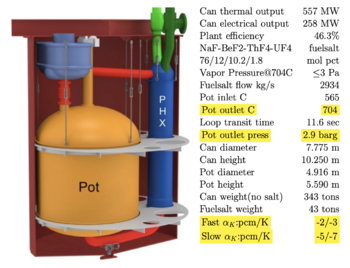ThorCon nuclear reactor: Difference between revisions
imported>David MacQuigg (→Safety) |
imported>David MacQuigg |
||
| Line 24: | Line 24: | ||
== Weapons Proliferation == | == Weapons Proliferation == | ||
The sealed cans are inside a silo under a heavy concrete lid. Any attempt to get inside the silo | The sealed cans are inside a silo under a heavy concrete lid. Any attempt to get inside the silo can be easily detected and stopped by local police or military. | ||
All fissile material is in inaccessible high-radiation areas. Uranium is always | |||
low-enriched. Plutonium is always diluted with thorium, in fuel salt with hazardous fission products.<ref>https://thorconpower.com/wp-content/uploads/2019/03/ThorConSpecSheet7.pdf</ref> | |||
== Cost == | == Cost == | ||
The expected cost of a complete power plant will be less than a coal plant of equal power.<ref>See sections 6 and 7 of https://thorconpower.com/docs/docs_v130_isle20190315.pdf</ref> | The expected cost of a complete power plant will be less than a coal plant of equal power.<ref>See sections 6 and 7 of https://thorconpower.com/docs/docs_v130_isle20190315.pdf</ref> | ||
Revision as of 11:47, 30 October 2021
- See also: Nuclear_power_reconsidered
These reactors (and the entire power plant) are to be manufactured on an assembly line in a shipyard, and delivered via barge to any ocean or major waterway shoreline. The reactors are delivered as a sealed unit and never opened on site. All maintenance and refueling is done at a secure location.
This article is a brief summary. For more details see the ThorCon documents.[1]
Safety
Accidental overheating. There is a plug at the bottom of the reactor vessel that melts if the reactor gets too hot, and allows the fuel to flow out of the reactor and into some drain tanks, where the fission reaction stops, and the decay heat is absorbed by a "cold wall". No operator action is required, and there is nothing an operator can do to stop the safe shutdown. The reactor is "walk-away safe".
Leakage of Radioactivity Three gas-tight barriers - the Pot, the Can, and the Silo.
Sabotage The hull is 3 feet of sand with an inch of steel on each side, capable of blocking a jumbo jet with nine-ton engines. Reactivity is increased by adding fuel through an orifice inside the silo, out of reach of any rogue operator. The maximum rate of increase in reactivity is enough for load following, but never enough that the reactor can go prompt critical.[2]
Waste Management
All maintenance and fuel processing is done at a secure location.
Tonnes per year for a 500MW plant:
High Level Waste:
Medium and Low Level Waste:
Recycled Fuel:
Other: (Medical isotopes, etc.)
Weapons Proliferation
The sealed cans are inside a silo under a heavy concrete lid. Any attempt to get inside the silo can be easily detected and stopped by local police or military.
All fissile material is in inaccessible high-radiation areas. Uranium is always low-enriched. Plutonium is always diluted with thorium, in fuel salt with hazardous fission products.[3]
Cost
The expected cost of a complete power plant will be less than a coal plant of equal power.[4]
Specs for a 500MW plant:[5]
Plant cost per kW: $1200
Operating cost per kWh: $0.03
Fuel consumption per year: 1.93 tonnes of 19.7% enriched uranium plus 4 tonnes thorium.
Notes and References
- ↑ ThorCon Isle
- ↑ https://thorconpower.com/wp-content/uploads/2019/03/ThorConSpecSheet7.pdf
- ↑ https://thorconpower.com/wp-content/uploads/2019/03/ThorConSpecSheet7.pdf
- ↑ See sections 6 and 7 of https://thorconpower.com/docs/docs_v130_isle20190315.pdf
- ↑ https://thorconpower.com/wp-content/uploads/2019/03/ThorConSpecSheet7.pdf
